Chapter: 12th Statistics : Chapter 6 : Index Numbers
Unweighted Index Numbers
METHODS OF CONSTRUCTING INDEX NUMBERS
Different types of index number (price/quantity/value) can be
classified as follows.

Unweighted Index Numbers
An unweighted price Index Number measures the percentage change in
price of a single item or a group of items between two periods of time. In
unweighted index numbers, all the values taken for study are of equal
importance. There are two methods in this category.
(i) Simple aggregative method:
Under this method the prices of different items of current year
are added and the total is divided by the sum of prices of the base year items
and multiplied by 100.

p1 = Current year prices for various commodities
p0 = Base year prices for various commodities
P01 = Price Index number
Limitations of the simple aggregative method
(i) Relative importance of the commodities is not taken into
account.
(ii) Highly priced items influence the index number
Example 6.1
Construct the Price Index Number for the year 1997, from the
following information taking 1996 as base year.

Solution:
Construction of Price Index:
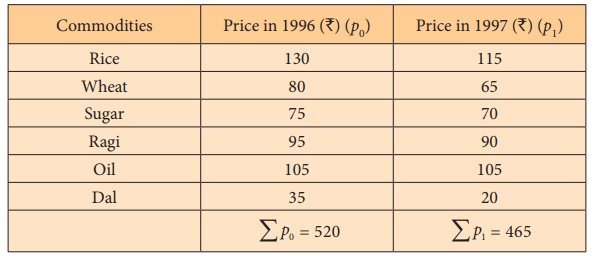
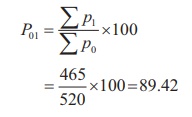
Price Index in 1997, when compared to 1996 has fallen by 10.58%
Example 6.2
Calculate Price Index Number for 2016 from the following data by
simple aggregate method, taking 2016 as base year.

Solution:

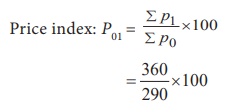
= 3600/29
P01 = 124.13%
Price index for the year 2016 when compared to 2015 has been
increased by 24.13%.
2. Simple average of price relative method
Under this method, first of all price relatives are obtained for
the various items and then average of these relatives is obtained by using
either arithmetic mean or geometric mean. Price relative is the price of the
current year expressed as the percentage of the price of the base year. The
formula for computing Index Number under this method on using Arithmetic mean
and Geometric mean are given below.
If N is the member of items, p1 is the
price of the commodity with current year and p0 is the price
of the commodity in the base year then, the average Price Index Number is
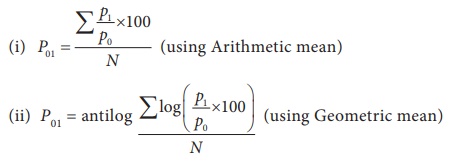
Advantages of Average Price Index
1. It is not influenced by the extreme prices of
items as equal importance is given to all items.
2. Price relatives are pure numbers; therefore the value of the
average price relative index is not affected by the units of measurement of
commodities included in the calculation of index numbers.
Limitations
1. Equal weights are assigned to every commodity
included in the index. Each price relatives is given equal importance, but in
actual practice, it is not true.
2. Arithmetic mean is very often used to calculate the average
price relatives, but it has a few disadvantages. The use of geometric mean is
difficult to calculate.
Example 6.3
Compute price index number by simple average of price relatives
method using arithmetic mean and geometric mean.

Solution:
Calculation of price index number by simple average of price
relatives:

(i) Price relative index number based on arithmetic mean:

(ii) Price relative index number based on geometric mean:

= antilog (2.13303)
= 134.9
Hence, the price index number based on arithmetic mean and
geometric mean for the year 2002 are 137.34 and 134.9 respectively.
Example 6.4
Construct simple average price relative index number using
arithmetic mean for the year 2012 for the following data showing the profit
from various categories sold out in departmental stores.

Solution:
Index number uning Arithmertic Mean of price
relatives

Simple average price relatives using A.M =
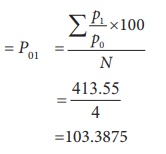
=103.3875
P01 = 103.39
The average price relative index number using arithmetic mean for
the year 2012 is 103.39
Example 6.5
Construct simple average price relative index number using
geometric mean for the year 2015 for the data showing the expenditure in
education of the children taking different courses.

Solution:

P01 = antilog (∑ log P / N )
= antilog ( 8.1709 / 4)
= antilog (2.04275)
= antilog (2.0428)
= 110.4
The average price relative index number using geometric mean for
the year 2015 is 110.4
Related Topics